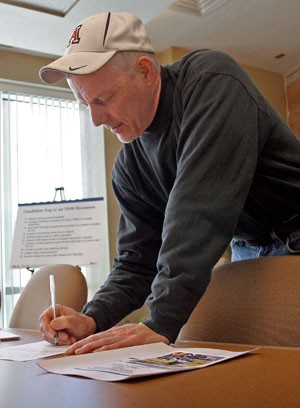Students, faculty and staff who had any gripes with commuting and parking on campus were given the opportunity to speak out yesterday at the Parking and Transportation Services Travel Demand open house.
They were invited to visit the Sabino Room in the Student Union Memorial Center to hear presented information and proposed solutions to the parking crunch, and offer feedback and ideas.
The forum was held to prepare for the significant growth projected for the campus over the next few years.
PTS also is trying to find a way to efficiently use transportation resources.
The projected UA population for 2010 is 56,100 people compared to 47,815 in 2006-2007.
Jim Witkowski, a project manager with Morrison Maierle, Inc., said the study was created to look at existing commuter needs as well as to plan for the future.
The Pima Association of Governments, the UA, Sun Tran, the City of Tucson, students and neighborhood associations, evaluated and ranked the top 20 ideas to fix the parking problem and picked what would be the most effective and possible to implement.
Some options that PTS is thinking about include creating a universal transit pass included in the price of tuition, increasing parking costs, prohibiting freshman from bringing cars to campus, more internet based classes and not issuing parking permits to students living on campus.
Witkowski said they’ve done a lot of research including mapping student and employee residential locations and how they get to work. They are looking into having the two to five mile travelers use public transportation, biking and carpooling.
“”The main byproduct is how we’re going to improve as growth occurs in the short term,”” said James Beier, an alumnus in civil engineering currently working on the project with Morrison Maierle, Inc.
“”Its already hard to get around campus,”” he said. “”Its something that needs to be addressed, and that’s what the study is for.””
Witkowski said the UA is the most traveled location in Tucson and is growing faster than parking can handle.
“”There’s so many trips to and from campus everyday. It’s such a huge trip generator, as it changes and grows, studies like this need to be periodically done,”” Beier said.
“”If you don’t know what the conditions are, you can’t plan for the future,”” said Patrick Kass, director of PTS.
He said he has seen a good mix of staff and students stopping by and appreciates feedback, because it leads to better decisions.
Kass said they are geared toward implementing these plans in fall 2009 so they have time to analyze the programs including looking at a new parking garage on the south side of campus.
He said they are budgeting $16,000 per parking space for the new parking garage.
The price has more then doubled from when they built the Tyndall Avenue Parking Garage for $7,000 per space in 2000, Kass said.
Kass said the maximum number of parking spaces the UA can sustain is 12,000 due to the size of the campus and roads. He said now it is about 12,500, but the number goes up and down depending on construction.
Amber Soergel, an academic advisor in the physiology department, came to the open house to give feedback and share her concerns on the mass transit system around the UA.
Soergel said it takes her 35 minutes to commute every day, and she pays for a garage at the same price students do, which she doesn’t feel is fair.
She said she would use an alternative mode of transportation if one was provided for her.
“”I think they have a lot of work ahead of them,”” Soergel said.
Alice Roe is chair of the Campus Community Relations Committee, which deals with neighborhoods around campus and has worked with PTS to solve problems in the past.
“”We’re intensely interested in what happens,”” Roe said.
She said when there isn’t enough parking at the UA, students spill over and park in nearby neighborhoods for free, and their cars are a hassle and can block things like garbage pick up.
PTS has an online feedback form that can be accessed at parking.arizona.edu through the end of the week.









